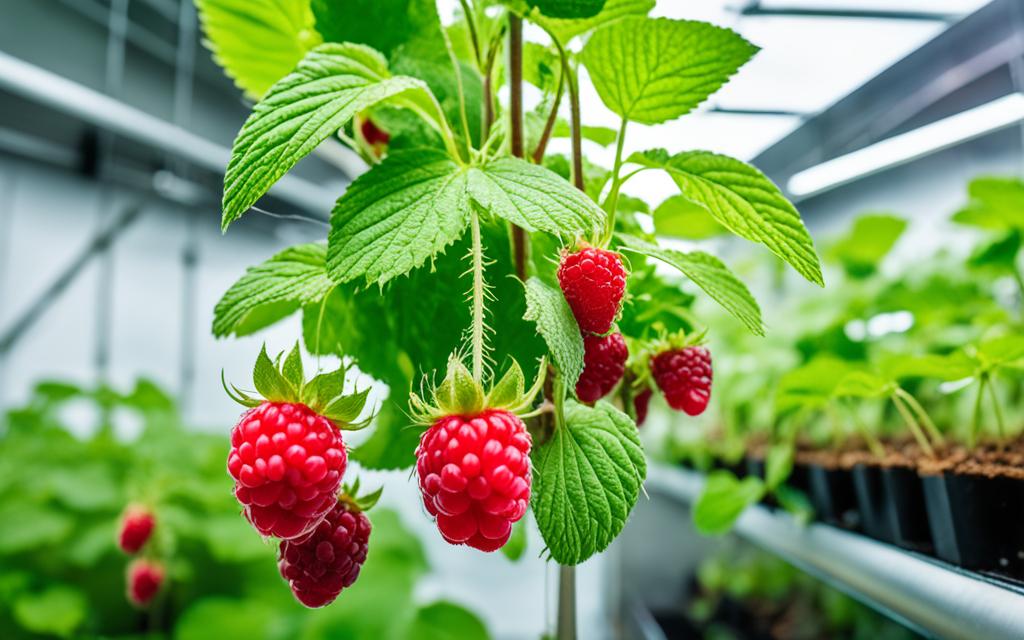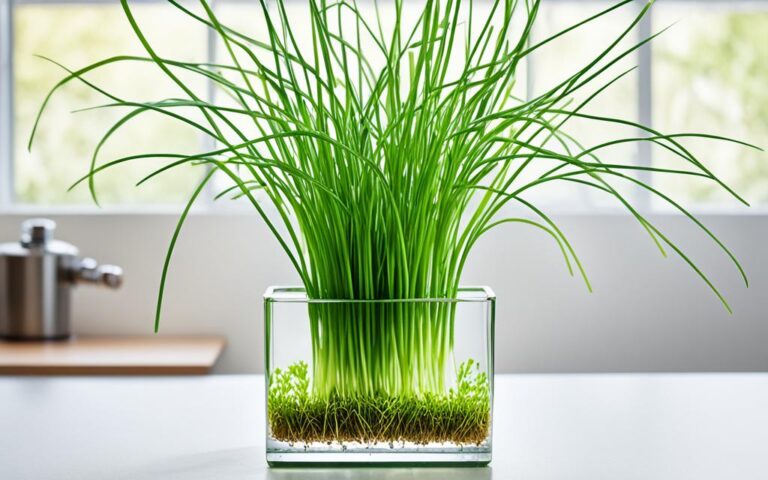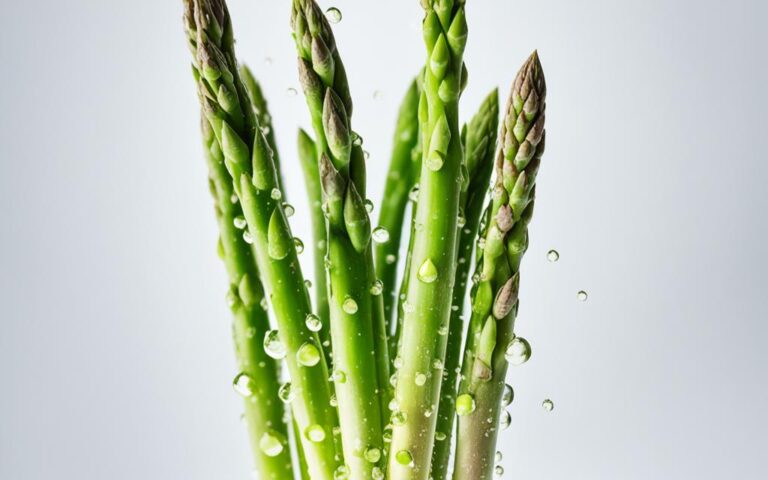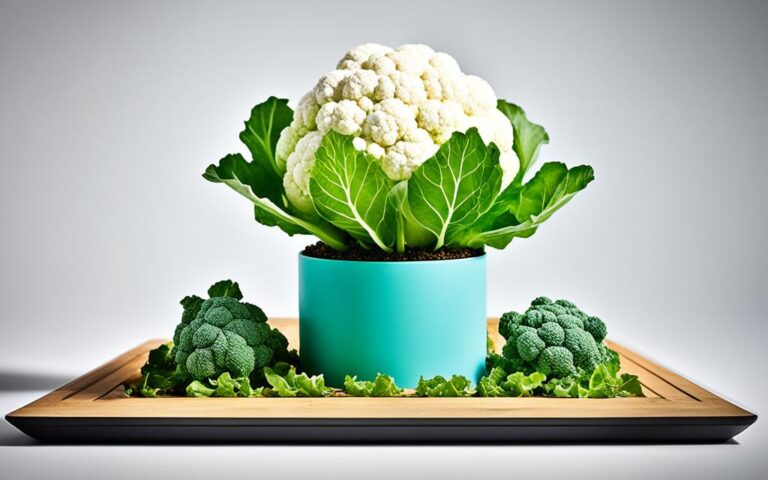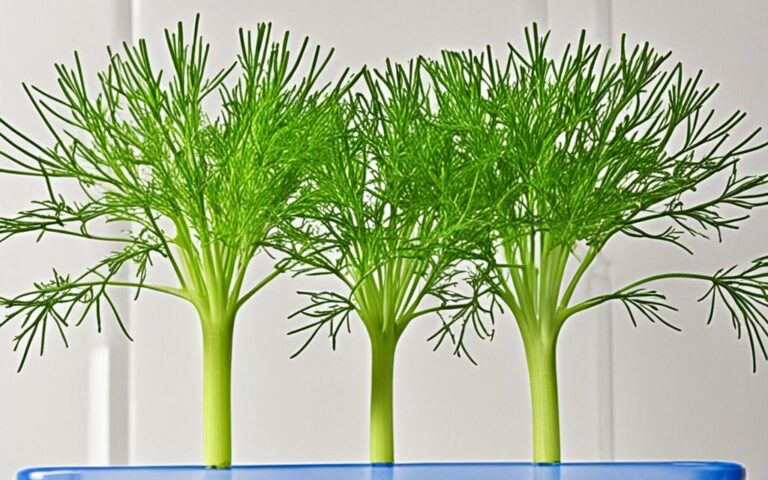Hydroponic Raspberries: Grow Lush Berries at Home
Did you know hydroponic raspberries can produce up to 10 times more fruit per square foot than traditional farming? This new way of growing is changing how we get those delicious, juicy raspberries at home. With hydroponic methods, you can have a steady supply of these tasty berries all year, even in small spaces.
Key Takeaways
- Hydroponic raspberries can yield up to 10 times more fruit per square foot than soil-based methods.
- Hydroponic cultivation allows for year-round harvesting and space-efficient growing.
- Raspberries can be successfully cultivated without soil using a nutrient-rich water solution.
- Choosing the right raspberry varieties, growing medium, and lighting requirements are crucial for thriving hydroponic raspberries.
- Proper nutrient management, temperature and humidity control, and pruning techniques are essential for maximizing yield.
This article will cover the main steps and what you need for growing tasty hydroponic raspberries at home. We’ll talk about picking the best varieties and creating the perfect growing space. Get ready to enjoy a lot of fresh, juicy raspberries from your own hydroponic setup!
What is Hydroponics?
Hydroponics is a new way to grow plants without soil. It uses a water solution full of nutrients instead of soil. This method lets farmers control the plants’ environment well. It’s great for growing many crops, including tasty raspberries.
Soilless Plant Cultivation
Plants in hydroponics grow in a special water solution, not soil. Their roots hang in this water, getting all the nutrients they need. This way, farmers can easily change the nutrients and conditions for the best plant growth.
Nutrient-Rich Water Solution
The secret to hydroponics is the nutrient-rich water. This water has everything plants need to grow well, like nitrogen, phosphorus, and iron. By giving plants these nutrients right at their roots, hydroponics helps plants grow big and strong, better than in soil.
| Nutrient | Role in Plant Growth |
|---|---|
| Nitrogen (N) | Promotes green, leafy growth and overall plant vigor |
| Phosphorus (P) | Supports root development and flowering/fruiting |
| Potassium (K) | Enhances drought tolerance, disease resistance, and overall plant health |
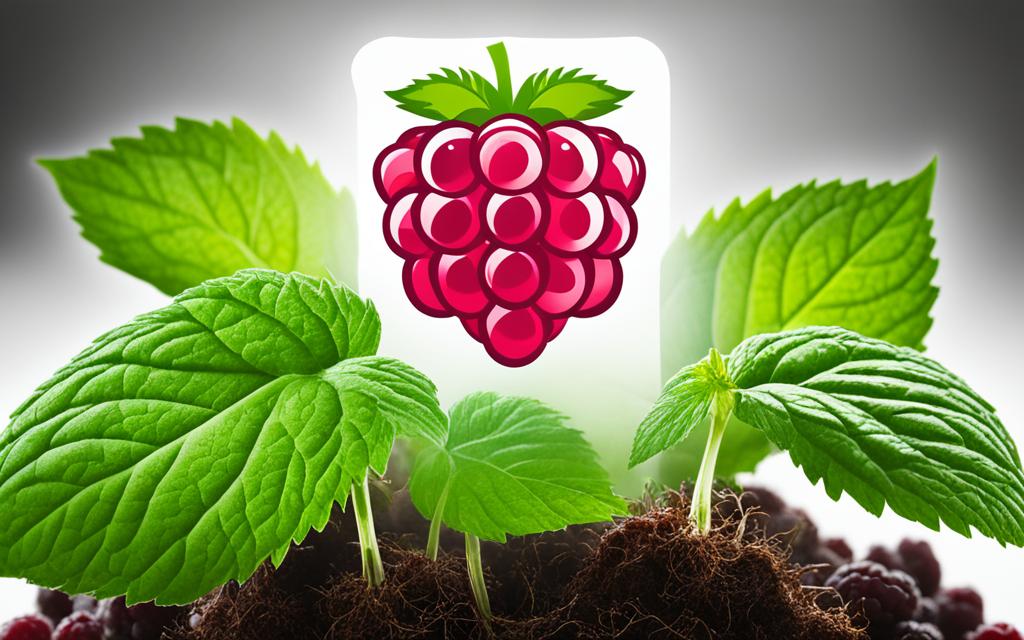
Hydroponics uses soilless plant cultivation and nutrient-rich water solutions for growing many crops. This includes the popular hydroponic raspberries. It’s a new and efficient way to grow food.
Benefits of Growing Raspberries Hydroponically
Growing raspberries hydroponically has many advantages over traditional soil methods. This method gives growers precise control, helping them get the most out of these tasty berries. It also means a harvest all year round.
Year-Round Raspberry Harvest
Hydroponic raspberry farming lets you pick berries all year. Outdoor raspberries grow with the seasons, but hydroponics keeps conditions perfect all year. This means you always have fresh, tasty raspberries.
Space-Efficient Raspberry Growing
Hydroponic systems are great for saving space. They need much less land than traditional farms. This makes them perfect for small gardens or indoor growing. By stacking trays or using vertical setups, you can grow more in less space.
The key benefits of hydroponic raspberry cultivation are getting berries all year and saving space. Hydroponics offers precision and efficiency. This lets both home and commercial growers get the best from these berries.
Selecting the Right Raspberry Varieties
Choosing the right raspberry varieties is key when growing them hydroponically. Heritage and Autumn Bliss raspberries are two top picks for a soilless setup.
Heritage Raspberries
Heritage raspberries are known for their adaptability and compact size. They’re perfect for hydroponic systems. These berries are reliable and produce a lot of tasty fruit.
Autumn Bliss Raspberries
Autumn Bliss raspberries also excel in hydroponics. They grow well in controlled environments, giving you lots of flavorful berries all season.
Picking the best hydroponic raspberry varieties is vital for a great harvest. Choosing Heritage and Autumn Bliss increases your chances of a successful crop all year.
Setting Up Your Hydroponic System
Growing raspberries hydroponically means picking the right hydroponic system. The Nutrient Film Technique (NFT) and the Deep Water Culture (DWC) systems are great for this. They use water channels or reservoirs to send nutrients straight to the roots. This helps the plants grow well and produce lots of berries.
Nutrient Film Technique (NFT)
The Nutrient Film Technique (NFT) uses a shallow, flowing stream of nutrients to feed the roots. It’s efficient, needing less water and nutrients. This makes it perfect for small-scale growers.
Deep Water Culture (DWC)
With a Deep Water Culture (DWC) system, the roots are in a tank full of nutrients. This setup gives the roots constant nutrients and oxygen. It’s great for growing raspberries on a bigger scale.
| Hydroponic System | Key Features | Ideal for |
|---|---|---|
| Nutrient Film Technique (NFT) | Shallow, continuously flowing stream of nutrient-rich water | Small-scale hydroponic raspberry growers |
| Deep Water Culture (DWC) | Plant roots submerged in a nutrient-dense water reservoir | Larger-scale hydroponic raspberry cultivation |
Choosing the right hydroponic system is important for growing raspberries. Make sure to follow the instructions and get advice from experts. This will help you have a successful hydroponic raspberry harvest.
“Hydroponic systems provide an efficient and controlled environment for growing raspberries, allowing for year-round production and maximizing yields in limited spaces.”
Choosing the Right Growing Medium
Choosing the right growing medium is key for hydroponic raspberry success. Coconut coir and perlite are top choices that work well.
Coconut Coir
Coconut coir comes from coconut husks and is great for hydroponics. It’s good at draining and aeration, helping raspberry roots grow well. It also holds water and nutrients, keeping plants moist but not soggy.
Perlite
Perlite is a good option for hydroponic raspberries too. It’s a light, mineral-rich material that improves soil and holds water well. This helps roots grow strong and gets nutrients to the plants easily, leading to healthy growth and lots of fruit.
Coconut coir and perlite are popular for hydroponic raspberry growing medium. They support plant health and productivity. Picking the right medium ensures your hydroponic raspberries get what they need to thrive.
“Selecting the appropriate growing medium is a critical step in establishing a successful hydroponic raspberry system. Coconut coir and perlite offer proven solutions that can help you achieve lush, bountiful harvests.”
Lighting Requirements for Hydroponic Raspberries
Raspberries need a lot of light to grow well in a hydroponic setup. They should get 12 to 16 hours of light every day. Using led grow lights helps mimic the sun’s light, giving them the right spectrum and intensity for growth.
Raspberries love light and need it to grow and produce fruit well. Without soil, the right hydroponic raspberry lighting is even more crucial. The right lights can greatly improve your harvest.
| Light Requirement | Recommended Specification |
|---|---|
| Daily Light Exposure | 12 to 16 hours |
| Light Intensity | 400-600 micromoles per square meter per second (μmol/m²/s) |
| Light Spectrum | Balanced spectrum with red, blue, and far-red wavelengths |
When picking led grow lights for hydroponic raspberries, choose ones that match the recommended specs. Proper lighting helps create a great environment for your plants. This leads to healthy growth and lots of berries.
Nutrient Solution and pH Levels
Growing hydroponic raspberries needs a balanced nutrient solution for best growth and fruiting. This solution must have the key macronutrients like nitrogen, phosphorus, and potassium. It also needs the important micronutrients iron, magnesium, and calcium.
Essential Nutrients
The hydroponic raspberry nutrient solution must give the plants the right nutrients. A good solution includes these main elements:
- Nitrogen (N) for healthy leaves and stems
- Phosphorus (P) for roots and fruit growth
- Potassium (K) for plant strength and fighting diseases
- Iron (Fe) for making chlorophyll and keeping leaves green
- Calcium (Ca) for strong cell walls and better fruit quality
- Magnesium (Mg) for photosynthesis and taking in nutrients
Maintaining Optimal pH
Along with the essential nutrients for hydroponic raspberries, keeping the optimal pH level is key. This ensures the plants take in nutrients well and stay healthy. The best pH range for these plants is between 5.5 and 6.5.
| Nutrient | Function | Optimal Range |
|---|---|---|
| Nitrogen (N) | Foliage and stem growth | 50-150 ppm |
| Phosphorus (P) | Root development, fruit production | 30-60 ppm |
| Potassium (K) | Overall plant vigor, disease resistance | 50-150 ppm |
| Iron (Fe) | Chlorophyll production, green leaf health | 2-5 ppm |
| Calcium (Ca) | Strong cell walls, fruit quality | 80-120 ppm |
| Magnesium (Mg) | Photosynthesis, nutrient uptake | 30-50 ppm |
Temperature and Humidity Control
Growing hydroponic raspberries needs careful attention to temperature and humidity. The right climate is key for healthy plants and a big harvest.
The best daytime temperature for hydroponic raspberries is about 70°F (21°C). This temperature is perfect for the plants to grow well and produce lots of juicy berries. At night, it’s good to have cooler temperatures, around 60-65°F (15-18°C), for the plants to rest and recover.
Humidity is also crucial. Hydroponic raspberries do best in a humid environment with a level between 60-80%. This helps prevent mold and keeps the plants healthy and strong.
- Maintain a daytime temperature of around 70°F (21°C) for optimal raspberry growth
- Allow for a slight temperature drop at night, around 60-65°F (15-18°C)
- Ensure a relative humidity between 60-80% to support healthy plants and prevent disease
“Precise temperature and humidity control are the keys to unlocking the full potential of your hydroponic raspberry garden.”
By keeping the right temperature and humidity, you can make a great environment for your hydroponic raspberries. This leads to a big and tasty harvest all year.
Pruning and Training Raspberry Plants
Keeping your hydroponic raspberry plants healthy and productive needs careful pruning and training. Removing dead or sick canes helps new growth. Training them makes sure they get enough light and boosts their productivity.
Pruning Hydroponic Raspberries
Pruning your hydroponic raspberries is key. It does several things:
- Gets rid of dead, damaged, or sick canes that can spread pests and diseases
- Helps new, strong canes grow
- Improves air flow, lowering the chance of fungal infections
- Makes the plant focus on making high-quality fruit
Prune your hydroponic raspberries in late winter or early spring, before they start growing new. Cut dead or damaged canes at the base. Thin out crowded spots for better air flow.
Training Hydroponic Raspberry Plants
Training your hydroponic raspberry plants is also crucial for their growth and yield. Using a trellis or support helps:
- Make sure the canes get enough sunlight
- Stop the plants from getting tangled or spreading out too much
- Make harvesting and caring for them easier
You can use methods like the T-trellis or V-trellis systems. Choose one and train the canes as they grow. Guide them on the support for the best growth and fruit.
“Proper pruning and training are essential for achieving a bountiful hydroponic raspberry harvest.”
By pruning and training your hydroponic raspberry plants well, you create the perfect setting. They’ll thrive and give you a lot of tasty, nutrient-rich berries.
Pollination Techniques for Hydroponic Raspberries
Growing hydroponic raspberries is tricky when it comes to pollination. Raspberries usually get pollinated by wind outside. In hydroponics, growers must copy this process to get fruit.
To pollinate hydroponic raspberries, gently shake the plants all day. This action, like wind, moves pollen from flowers to stigmas. Or, a small fan can blow air around the plants to help pollinate them.
For artificial pollination for hydroponic raspberries, hand-pollination works well. Use a small brush or cotton swab to move pollen from one flower to another. This makes sure each flower gets pollinated.
It’s important to keep the hydroponic system at the right temperature and humidity for pollination. By doing this and using natural-like pollination methods, growers can get lots of tasty hydroponic raspberries.
Hydroponic Raspberries: Harvesting and Enjoying
Growing hydroponic raspberries brings great joy when it’s time to harvest. These berries are ready when they turn fully colored and come off the plant easily. Be gentle when picking to keep the fruit from getting damaged. Enjoy the fruits of your labor from your hydroponic garden.
Hydroponic raspberries are known for their amazing taste and health benefits. They’re perfect for many dishes, from desserts to salads. With a hydroponic system, you can pick these berries all year, giving you a steady supply of flavor.
Maximizing the Harvest
Here are some tips to get a lot of hydroponic raspberries:
- Keep an eye on the plants and pick berries when they’re fully colored and come off easily.
- Pick the raspberries carefully to avoid bruising them.
- Put the picked berries in the fridge to keep them fresh longer.
Enjoying Hydroponic Raspberries
Hydroponic raspberries are great in the kitchen because of their taste and texture. Use them in:
- Delicious desserts like tarts, cobblers, and ice cream
- Fresh salads for a sweet and colorful touch
- Smoothies and yogurt parfaits for a healthy snack
| Nutrient | Hydroponic Raspberries | Field-Grown Raspberries |
|---|---|---|
| Vitamin C | 32 mg/100g | 26 mg/100g |
| Fiber | 6.5 g/100g | 5.3 g/100g |
| Antioxidants | High | Moderate |
Hydroponics lets you grow harvesting hydroponic raspberries with top quality. Enjoy these berries all year. Take pleasure in the delicious tastes from your hydroponic garden.
Common Issues and Troubleshooting
Growing hydroponic raspberries can be tricky, but with the right steps, growers can beat common problems. Focus on pest and disease management and nutrient deficiencies.
Pest and Disease Management
Spider mites can harm hydroponic raspberry plants, making leaves turn yellow and slowing growth. It’s important to watch closely and act fast to control these pests. Using natural predators or organic sprays can help.
Powdery mildew is another issue for hydroponic raspberries. Good air flow, the right humidity, and regular cleaning can stop these diseases before they start.
Nutrient Deficiencies
Keeping an eye on the nutrients in the hydroponic solution is key for healthy raspberry plants. Nutrient deficiencies in hydroponic raspberries can cause slow growth, leaves that don’t look right, and fewer berries. Testing the pH and adjusting nutrients as needed keeps plants thriving.
By being alert, controlling pests and diseases well, and keeping nutrients balanced, hydroponic raspberry growers can beat these issues. This leads to a great harvest.
Tips for Maximizing Yield
To get the most out of your hydroponic raspberries, focus on key growing system aspects. By using smart techniques, you can boost your berry production. This way, you’ll have a steady supply of these tasty berries all year.
Keeping the right nutrient mix for your raspberry plants is key. Make sure the water has the right minerals and nutrients for strong growth and tasty berries. It’s also important to check and adjust the pH levels often. This helps the plants take in nutrients well.
Temperature and humidity are crucial for growing raspberries in hydroponics. The right conditions help keep your plants healthy and productive. Use climate control systems or place your setup right to create the best environment for your raspberries.
Pruning and training your raspberry plants wisely can also increase your yield. By shaping the plant and removing weak canes, you help it focus on growing bigger, juicier berries. Regular care and shaping help your plants grow better and produce more.
Lastly, make sure your raspberry plants get enough light. This can come from the sun or grow lights. Good lighting is key for photosynthesis and making more flowers and fruit. Plan your lighting carefully to help your raspberries grow and thrive.
By focusing on these areas, you can make the most of your hydroponic raspberry plants. Enjoy a steady supply of these delicious berries all year round.
| Strategies for Maximizing Hydroponic Raspberry Yield | Benefits |
|---|---|
| Optimizing Nutrient Solution | Promotes vigorous growth and superior berry quality |
| Maintaining Ideal Temperature and Humidity | Enhances plant health and productivity |
| Implementing Effective Pruning and Training Techniques | Redirects plant energy into developing larger, more flavorful berries |
| Ensuring Adequate Lighting | Supports photosynthesis and encourages more flowers and fruit |
“By focusing on these key factors, you can unlock the full potential of your hydroponic raspberry plants and enjoy a bountiful, year-round supply of these delectable berries.”
Optimizing Nutrient Solution
Balance the essential minerals and nutrients in the water for better growth and berry quality.
Maintaining Ideal Temperature and Humidity
Keep the growing area at the best temperature and humidity for raspberries. This boosts health and productivity.
Implementing Effective Pruning and Training Techniques
Manage the plant’s shape and remove weak canes to focus energy on bigger, tastier berries.
Ensuring Adequate Lighting
Good lighting supports photosynthesis and helps grow more flowers and fruit.
Conclusion
Growing hydroponic raspberries is an exciting and rewarding journey. It lets you have a steady supply of tasty, nutrient-rich berries at home. You can choose from heritage or autumn-bearing types, but success depends on knowing their needs and how to care for them.
Choosing the right growing medium and lighting is crucial. Keeping nutrients and temperature right is also key for a good harvest. By getting these things right, you can make your home a place where hydroponic raspberries grow well. You’ll enjoy fresh, tasty berries all year.
Starting this journey with hydroponic raspberries means facing challenges and learning from them. With the right approach and a love for growing your own food, you can make the most of hydroponic raspberries. They offer many benefits. Let your urban garden grow and enjoy the fruits of your labor.
